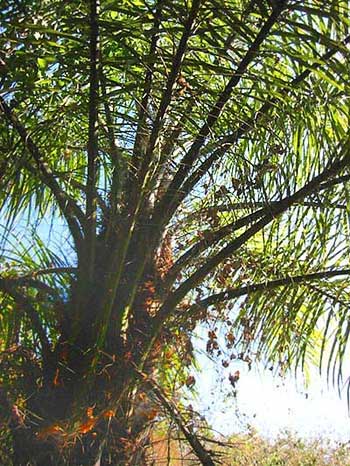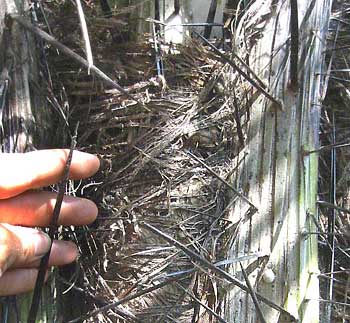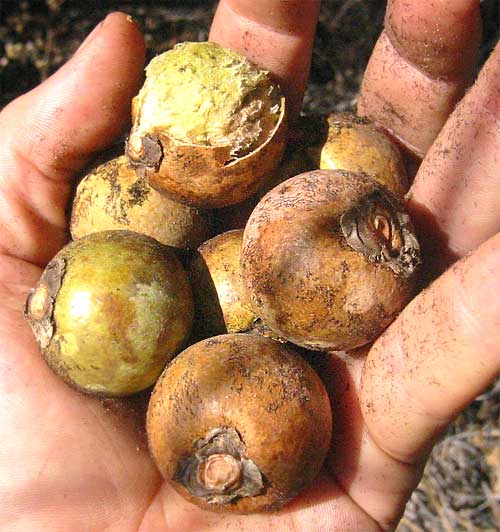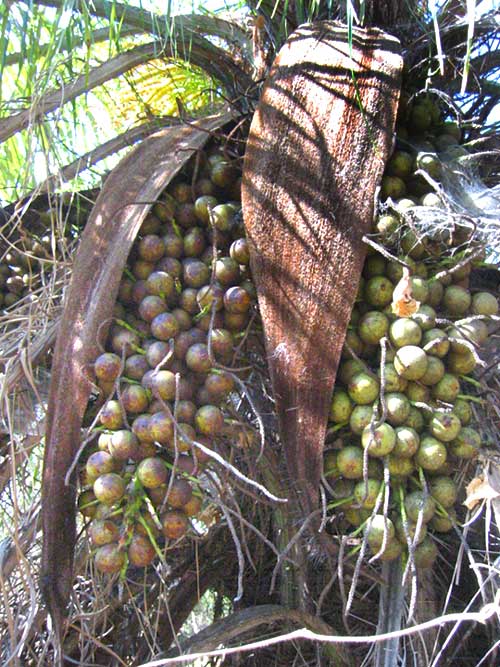Excerpts from Jim Conrad's
Naturalist Newsletter
from the February 18, 2008 Newsletter written in the community of 28 de Junio, in the Central Valley 8 kms west of Pujiltic, elev. ~700m (2300ft), ~N16.331°, ~W92.472°; southeastern Chiapas state, MÉXICO
"COYOL," THE VERY SPINY PALM

Above you see one of the more unusual trees in our landscape, a palm that at a distance looks like an upside-down feather duster, and bearing more spines than would seem necessary. It's ACROCOMIA ACULEATA, called Coyol here.
Below you can see just how spiny the palm is, where my hand can hardly find a place among the trunk's many long and short spines jutting out at odd angles. In the picture's center the thing looking like a bird nest is the natural fiber often produced at the bases of palm fronds. You may remember the neater-looking fiber mats at the bases of Coconut Palm fronds examined back in the Yucatan, a picture of which still resides online at www.backyardnature.net/yucatan/cocofibr.jpg

I've often wondered why a palm would go to such extremes of spininess. Half the spine density would seem enough to keep nearly any animal away. If I had to guess I'd say that the extreme spininess helps the palm create its own microhabitat. Especially now masses of leaves from dry-season-deciduous trees are collecting in the palms' crowns and between frond- petioles and trunks. Spiders, especially those constructing large funnel-webs with tunnels at one side, anchor their webs among the spines, gathering even more leaves and debris. These loose conglomerations attract insects who attract birds, lizards and more spiders, and then come things that eat birds, lizards and spiders.
Maybe the benefit of all this to the Coyol in that the decaying leaves, spider-discarded invertebrate carcasses and bird doo concentrate phosphorus and other precious nutrients around the palm.
from the April 14, 2008 Newsletter written in the community of 28 de Junio, in the Central Valley 8 kms west of Pujiltic, elev. ~700m (2300ft), ~N16.331°, ~W92.472°; southeastern Chiapas state, MÉXICO
COYOL NUTS
Earlier I was focused on the palm's spininess. Now their flowers and fruits are grabbing my attention. First see the size of the fruits below:

Then see the abundance with which they're produced below:

The two-ft-long fruit clusters are impressive enough, but maybe even more imposing are the semi-woody, spine-covered, brown "spathes" partially covering them. A spathe is a bract or leaf surrounding or subtending a flower cluster. It protects the flowers as they develop. Sometimes they stay small and fall off, but on Coyol obviously they enlarge into something substantial. Coyol's spathe might be more useful to humans if they weren't so spiny. Coconut Palms also produce conspicuous spathes. You can a Coconut Palm inflorescence emerging from its protective spathe halfway down the page at www.backyardnature.net/yucatan/coco-frt.htm.
In the upper left of our Coyol picture you can see several slender, yellow items. Those are spikes bearing many very small flowers. In the same picture remnants of those spikes can be seen emerging from the fruit clusters, now pale gray and stiff with age. Since fruits occur only at the bases of each of these grayish items, I'm assuming that on Coyol inflorescences male flowers occupy the top of the spike while fruit-producing female flowers are limited to the spike's lower part.
When I first saw how abundant the fruits were I began thinking I might have something to add to my diet here. However, the "nut" inside the hard shell was too hard to deal with.
"You eat them when they're younger," I was told. "Then they're softer inside. You put sugar on the nuts and they're good to suck on."
I asked about medicinal uses.
"Boil some leaves in water and make a tea," a young man told me. "It's good for bones, makes them strong, and keeps your joints in good shape."
"Nah, no good at that," an old man with bad arthritis contradicted in this traditional society where people seldom openly contradict one another.
"Well, if your bones and joints are in good shape," the young man compromised, "a tea of Coyol leaves keeps them that way.
The old man looked skeptical but didn't say a word.